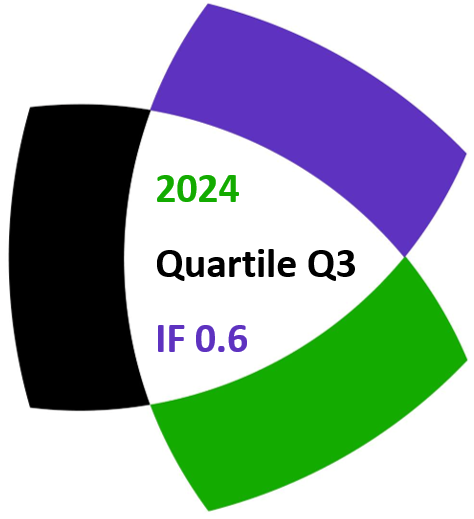Bahar Kuloğlu
Notes on Number Theory and Discrete Mathematics
Print ISSN 1310–5132, Online ISSN 2367–8275
Volume 31, 2025, Number 1, Pages 1–14
DOI: 10.7546/nntdm.2025.31.1.1-14
Full paper (PDF, 1037 Kb)
Details
Authors and affiliations
Bahar Kuloğlu ![]()
![]()
![]()
Department of Engineering Basic Sciences, Sivas Science and Technology University
Sivas, Türkiye
Abstract
In order to investigate the relationship between Gaussian Fibonacci numbers and quantum numbers and to develop both a deeper theoretical understanding in this study, q-Gaussian Fibonacci, q-Gaussian Lucas quaternions and polynomials are taken with quantum integers by bringing a different perspective. Based on these definitions, the Binet formula of these number sequences is found, and some algebraic properties, important theorems, propositions and identities related to the formula are given. Thus, new perspectives are obtained in the analysis and applications of complex systems.
Keywords
- Gaussian Fibonacci number
- Gaussian Lucas number
- Quaternion
- q-analog
- q-calculus
2020 Mathematics Subject Classification
- 11B83
- 16H05
- 05A30
References
- Akkus, I., & Kızılaslan, G. (2019). Quaternions: Quantum calculus approach with applications. Kuwait Journal of Sciences, 46(4), 1–13.
- Aşçı, M., & Gürel, E. (2013). Gaussian Jacobsthal and Gaussian Jacobsthal Lucas polynomials. Notes on Number Theory and Discrete Mathematics, 19(1), 25–36.
- Catarino, P. (2019). Bicomplex k-Pell quaternions. Computational Methods and Function Theory, 19(1), 65–76.
- Çimen, C. B., & İpek, A. (2016). On Pell quaternions and Pell–Lucas quaternions. Advances in Applied Clifford Algebras, 26(1), 39–51.
- Eser, E., Kuloğlu, B., & Özkan, E. (2023). On the Mersenne and Mersenne–Lucas hybrinomial quaternions. Bulletin of the Transilvania University of Brașov. Series III: Mathematics and Computer Science, 3(65)(1), 129–144.
- Flaut, C., & Shpakivskyi, V. (2013). On generalized Fibonacci quaternions and Fibonacci–Narayana quaternions. Advances in Applied Clifford Algebras, 23(3), 673–688.
- Halıcı, S., & Öz, S. (2018). On Gaussian Pell polynomials and their some properties. Palestine Journal of Mathematics, 7(1), 251–256.
- Jordan, J. H. (1965). Gaussian Fibonacci and Lucas numbers. The Fibonacci Quarterly, 3(4), 315–318.
- Kac, V., & Cheung, P. (2001). Quantum Calculus. Springer Science & Business Media.
- Khrennikov, A., Klein, M., & Mor, T. (2010). Quantum integers. AIP Conference Proceedings, 1232(1), 299–305.
- Kızılateş, C. (2020). A new generalization of Fibonacci hybrid and Lucas hybrid numbers. Chaos, Solitons & Fractals, 130, Article ID 109449.
- Kızılateş, C., Du, W.-S., Terzioğlu, N., & Chen, R.-C. (2024). New properties and matrix representations on higher-order generalized Fibonacci quaternions with q-integer components. Axioms, 13(10), Article ID 677.
- Kızılateş, C., & Polatlı, E. (2021). New families of Fibonacci and Lucas octonions with Q-integer components. Indian Journal of Pure and Applied Mathematics, 52, 231–240.
- Köme, S., Köme, C., & Catarino, P. (2022). Quantum calculus approach to the dual bicomplex Fibonacci and Lucas numbers. Journal of Mathematical Extension, 16(2), Article 7, 1–17.
- Kuloğlu, B., & Özkan, E. (2021). On generalized (k, r)-Gauss Pell numbers. Journal of Science and Arts, 3(56), 617–624.
- Kuloğlu, B., Özkan, E., & Shannon, A. G. (2023). p-Analogue of biperiodic Pell and Pell–Lucas polynomials. Notes on Number Theory and Discrete Mathematics, 29(2), 336–347.
- Kuloğlu, B., & Özkan, E. (2022). On the bicomplex Gaussian Fibonacci and Gaussian Lucas numbers. Acta et Commentationes Universitatis Tartuensis de Mathematica, 26(1), 33–43.
- Özkan, E., & Taştan, M. (2019). On Gauss Fibonacci polynomials, on Gauss Lucas polynomials and their applications. Communications in Algebra, 48(3), 952–960.
- Polatlı, E. (2018) On certain properties of quadrapell quaternions. Karaelmas Science and Engineering Journal, 8(1), 305–308.
- Slater, P. B., (2004). Volumes and hyperareas of the spaces of separable and nonseparable qubit-qutrit systems: Initial numerical analyses. Preprint. quant-ph/0405114, arXiv.
- Szynal-Liana, A., & Włoch, I. (2016). A note on Jacobsthal quaternions. Advances in Applied Clifford Algebras, 26(1), 441–447.
- Taş, S. (2019). A new family of k-Gaussian Fibonacci numbers. Balıkesir Üniversitesi Fen Bilimleri Enstitüsü Dergisi, 21(1), 184–189.
- Yılmaz, F., & Özkan, M. (2022). On the generalized Gaussian Fibonacci numbers and Horadam hybrid numbers: A unified approach. Axioms, 11(6), Article ID 255
Manuscript history
- Received: 20 March 2024
- Revised: 2 December 2024
- Accepted: 23 February 2025
- Online First: 26 March 2025
Copyright information
![]() Ⓒ 2025 by the Author.
Ⓒ 2025 by the Author.
This is an Open Access paper distributed under the terms and conditions of the Creative Commons Attribution 4.0 International License (CC BY 4.0).
Related papers
- Aşçı, M., & Gürel, E. (2013). Gaussian Jacobsthal and Gaussian Jacobsthal Lucas polynomials. Notes on Number Theory and Discrete Mathematics, 19(1), 25–36.
- Kuloğlu, B., Özkan, E., & Shannon, A. G. (2023). p-Analogue of biperiodic Pell and Pell–Lucas polynomials. Notes on Number Theory and Discrete Mathematics, 29(2), 336–347.
Cite this paper
Kuloğlu, B. (2025). A quantum calculus framework for Gaussian Fibonacci and Gaussian Lucas quaternion numbers. Notes on Number Theory and Discrete Mathematics, 31(1), 1-14, DOI: 10.7546/nntdm.2025.31.1.1-14.


